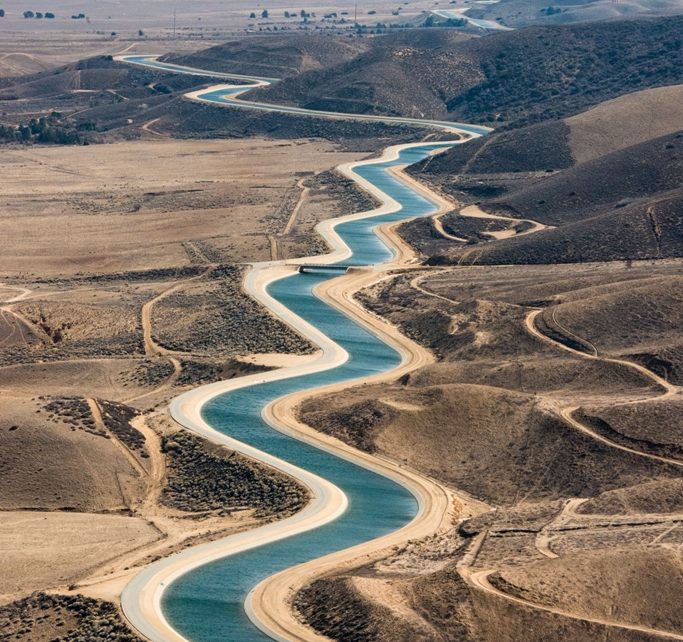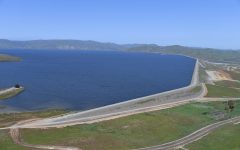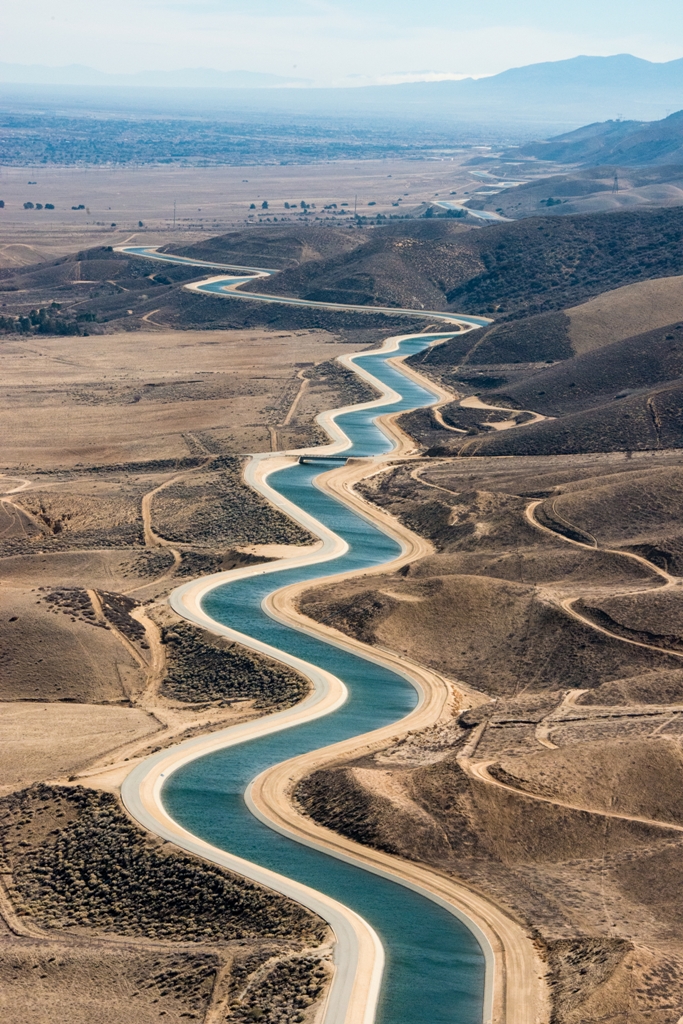
The California Aqueduct. (Photo: CA State Water Project)
Ringside: The Price of Scarcity
How much water does $7 billion buy?
By Edward Ring, December 27, 2023 6:00 pm
 How much water does $7 billion buy?
How much water does $7 billion buy?
In so many ways that it almost defies description, California’s lawmakers have relied on flawed logic to justify recently passed laws that will impose punitive urban water rationing. Rather than undertake the Sisyphean task of enumerating them, let’s just focus on one critical factor: the opportunity cost.
California’s urban water consumption is already down from over 9 Million Acre-Feet/year in the 1990s to only around 7.5 MAF/year today despite adding 8 million people to the state’s population over the past 30 years. Practical conservation measures have already been taken, so now the state Legislature wants us to kill “nonfunctional” lawns (and the trees that depend on lawn irrigation), and limit indoor water use to 42 gallons per day. The cost to implement these destructive, draconian edicts is estimated at over $7 billion. The benefit? An estimated savings of around 400,000 acre feet per year (this Dept. of Water Resources study estimates total savings of 340,515 acre feet per year – ref. page 61).
This is ridiculous. Not because Californians don’t face water scarcity. They do. The big reservoirs on the Colorado River, Lake Power and Lake Mead, stored over 50 MAF behind the dams 20 years ago, and now they’re nearly empty. As a result, California is likely to lose at least a million acre feet a year, maybe more, from its Colorado River allocation, because the water’s not there. In the San Joaquin Valley, groundwater pumping has long exceeded natural recharge by 2 MAF/year, and to restore those aquifers before they collapse, at least another 2 MAF/year has to stay underground. And then there’s the ever present threat of multi-year droughts.
So if we’re looking for 3 MAF/year or more just to eliminate acute water scarcity in California, isn’t there a better way to spend $7 million than merely to squeeze another 400,000 acre feet out of our urban residents? Let us count the ways.
Fish Friendly Delta Diversions: The Sacramento-San Joaquin Delta encompasses about 500,000 acres of waterways, levees, and farmland. Imagine allocating a mere 200 acres on an existing Delta island to divert up to 30,000 acre-feet per day into aquifer storage for subsequent use by farms and cities. Because these islands are below sea level and protected by levees, infiltration beds of gravel covering perforated water harvesting pipes could be built, with a parallel levee constructed to form a channel. Once that work is complete, openings could be cut into the existing levee on both ends of the new channel to allow water to flow through. Extensive study has already been performed on this project, with the next step being a pilot project to serve as final proof of concept. The cost for the pilot? Under $1 million. The estimated cost to implement? The total project cost for an infiltration channel, settling ponds, pumps, and new aqueduct transport to aquifer storage with interties to major existing north-south aqueducts: under $5 billion. During storm events even in dry years it would be possible to divert and store 2 MAF/year using this system, much more in wet years. Why isn’t every water worrier in California talking about this?
Build Desalination Plants Everywhere: Cue the skeptics. But the choice of the word “everywhere” wasn’t merely trolling. Credible plans to build inland plants to desalinate the Salton Sea are being taken seriously by environmentalists, as they should be. And to reduce the salt even in a reduced and managed Salton Sea would require a massive desalination plant; one mainstream study put the needed capacity at 100,000 acre feet per year. That is twice the capacity of the Carlsbad desalination plant that supplies up to 10 percent of San Diego County’s water. Desalination is a burgeoning, welcome salvation, providing desperately needed water in every other arid, ocean bordering metropolis on earth. For $7 billion, even using Carlsbad prices, Californians could construct desalination plants with a total capacity of 350,000 acre feet per year, and altogether they would only draw 140 megawatts of electricity. With emerging technologies – and perhaps some welcome regulatory reform – desalination plants would use even less energy and cost far less to build.
Build the Sites Reservoir – Now: When the decision was made in 1963 to build the San Luis Reservoir, the 2 MAF behemoth was completed in four years. It was part of the 1957 Water Plan. Also part of that plan were 48 other prospective locations for off-stream storage. For nearly 70 years, the Sites Reservoir has been the on-again, off-again twin to San Luis. Scaled down to 1.5 MAF of capacity, and no longer planned to have a pump storage component, the Sites Reservoir is nonetheless a vital next step in delivering water security to Californians. At an estimated cost of $4 billion and an estimated yield of 500,000 acre feet per year, this reservoir should have been completed years ago.
Stop Leaving So Much Water in the Rivers: This unimaginable heresy defies the legislative momentum of decades, and threatens those institutions that thrive on conflict, litigation, scarcity, emotional arguments, and apocalyptic hyperbole. Setting aside that dark but accurate assessment of what we’re up against, let’s consider the case in favor of arresting the trend. To begin with, if we want to save salmon, why aren’t we raising the limits on bass fishing? Bass, a nonnative predator, eat salmon. And if we want to save smelt, why not put smelt hatcheries next to nurseries in managed wetlands that exclude the nonnative Mississippi Silverside predators, only releasing them once they’re big enough to evade them? Why aren’t we planting shade trees along our waterways to get the water temperature down that way? Why aren’t we upgrading our water treatment plants so we don’t have to goose the flow of the rivers just to flush nitrogen out of the SF Bay and elsewhere? Why don’t we thin our forests not only to prevent superfires, but so more rainfall will percolate, feeding the springs and streams? Why don’t we recognize that flood irrigation has its place in modern agriculture, not only because it desalinates the soil, kills rodents, and primes the ground for a winter cover crop, but because the water recharges aquifers, taking pressure off river withdrawals for farm irrigation?
There are a lot of things that can be done for $7 billion that increase the supply of water, instead of imposing restrictions on urban residents that diminish their quality of life. Lowering indoor water use is in many respects a pointless exercise anyway, since the supposedly wasted water flows to a treatment plant where it is put right back into rivers. Along the coast, these treatment plants are being retrofit so the wastewater is pumped right back into the system. How is indoor water ever therefore wasted, if Californians average a comfortable 60 gallons per day instead of the to-be-mandated 42?
The real opportunities to achieve water abundance in California will not come from cutting back urban water use by 400,000 acre feet per year at stupendous cost. And while it is tempting for critics of urban water rationing to point to the thirsty farms, consuming a much greater 30 MAF/year, that is dead end thinking. Yes, we can take a million acres of irrigated farmland out of production. That would save 3-4 MAF/year. But if that’s all we do, instead of seizing the opportunity to invest in more water supply projects, we will just add food scarcity to water scarcity. We are all in this together, North and South, farm and city. We should be working together, and speaking with one voice, demanding investment in abundance, rather than paying for imposition of scarcity.
- Ringside: The Potential of Waste-to-Energy in California - April 17, 2024
- Ringside: How Much Water Will $30 Billion Buy? - April 10, 2024
- Ringside: Sacramento’s War on Water and Energy - April 4, 2024





{sigh}
Why does Newsom cooperate with the military and allow the spraying of Lord knows what to “control the weather” via whatever the hell it is they’re spraying high above us alll??.
For the longest time, I thought they were just contrails from high-flying planes, but then I got the FlightRadar app and started looking up more and more…
There was one Sunday morning Mrs. CD9 was visiting family and I arose at sunup to walk the dog. It was a perfectly clear, blue sky, sunny morning, no wind…
Looked up and there were four planes, tiny dots, they were so high, each spaced equally apart, laying down a trail…
All military tankers…
Within an hour, the formerly blue sky had turned a milky white, and the haze was palpable…
One guy theorizes they’re spraying dessicants, to absorb the moisture in the air, and as a student of the weather, I tend to agree…
One recent hyped-up storm developed offshore as a solid squall line on the radar, but mysteriously broke up as it made landfall and all the “StormWatch” hyperbole was useless as the front broke down – the radar images looked fake, like the front was turned off by a switch….
Having seen Newsom in action during the plandemic, I wouldn’t be surprised if he’s ordering the National Guard air guard to spray stuff that dries up the rain to create the shortages that we all have been experiencing….
His malevolence makes this dystopic vision a possibility….
The water issue is all part of the globalist plan to depopulate the planet for fun and profit. You suffer while they get rich. I doubt ANY of the elite leftists in this state have a house with a brown lawn. More than likely they water their estates to an excess to keep them green and lush.
Creating artificial scarcity of water and power is part of the WEF globalist’s agenda to control the masses and Newsom and the criminal gang of Democrat/RINO uni-party are implementing it to control Californians.